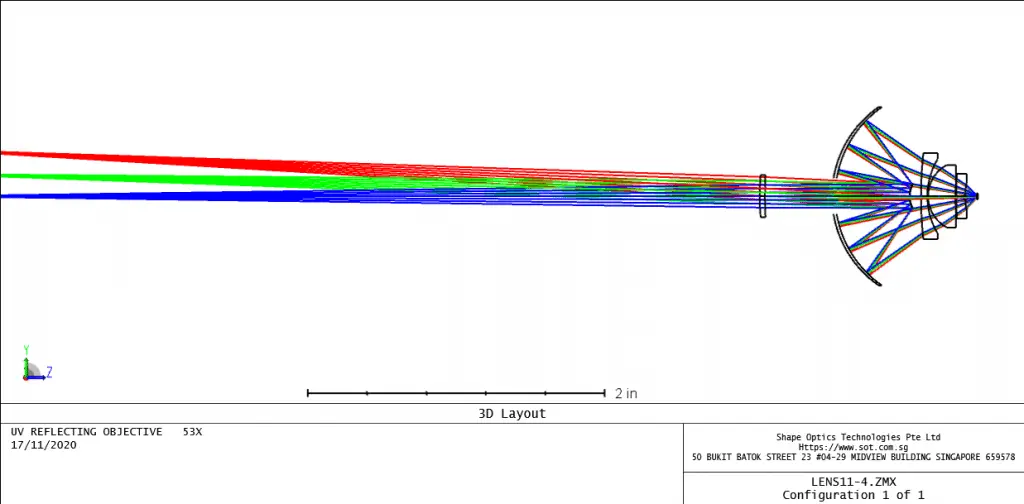Microscope objective are essentially diffraction-limited optical devices. How to design it, and what’s the design tips? Here we will share it.
These microscope objective lenses are characterized by specimen magnification and NA. The image is generally about 16 mm in diameter.

Figure UV reflective objective 53x
Most designs are based upon an old concept of 160-mm tube length. That is, the distance from the image to a principal plane in the objective was 160 mm. This corresponds to an object to image distance of about 180 mm. They were designed to be mounted on a precision shoulder 35.68 mm from the specimen that was covered by a 0.18-mm-thick glass. This cover glass is made either from fused silica (UV-type objectives) or a chemically resistant soda lime glass. Because this type of glass is reasonably close to N-K5, it is used in these designs. For an oil-immersion objective, an additional thickness of 0.14 mm of oil is placed between the cover glass and the first lens surface (generally a plane surface).
The objective thread is “Whitworth,” with a 558 included angle, 36 threads/in., 0.796 major diameter. Typical laboratory microscopes have a shoulder-to-specimen distance of 45 mm.
Several manufacturers have instituted infinity-corrected systems. This allows greater flexibility in microscope design. Various beam splitters and other accessories can now be readily inserted into the collimated beam. All designs shown here are for 180 mm object-to-image distance with a 16-mm diameter image. Also note that, although microscope magnification is listed as image diameter/specimen diameter, the usual convention of tracing from the long conjugate is followed here; in this case, it is from the 16-mm image diameter to the specimen. Thus magnification as computed from these prescriptions is the reciprocal of the listed magnification.
According to the Raleigh criterion, the distance between two resolved images is Z=0.61lamda/NA, where Z is the separation of the images, lamda is the wavelength of light, and NA= sinΘ. N is the refractive index of the medium in which is the image. Thus, to increase resolution, one needs to decrease the wavelength of the illumination system ( refer to figure 1, a UV objective) or increase the NA beyond 1. This is accomplished by immersing the object in oil (see Design 11.5, a 98 x oil-immersion objective as below).

Figure 98 x oil-immersion objective
Values of NA given in the following prescriptions are paraxial, that is,

The example as below shows a 4-mm EFL apochromatic objective for which NA is 0.91 (the actual focal length is 3.76 mm). Details are attached in the end of this article. There is some flare at the edge of the pupil and a very small amount of primary color. Note that the next to last lens surface (RZ0.09332) is nearly concentric about the image. The spherical contribution at this surface is then zero. Magnification is 47.5.
The design file used in this particle is attached, please download it here.4-mm EFL apochromatic objective UV reflective objective 53x

Reference Source:
- Laikin, Milton. Lens Design. CRC Press, 2007.
- https://www.zemax.com/
- Zemax Optical Design Program User’s Guide, Zemax Development Corporation
- https://en.wikipedia.org/wiki/Main_Page



